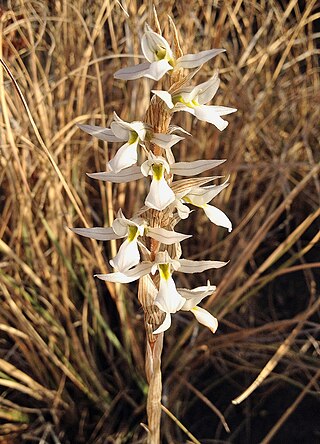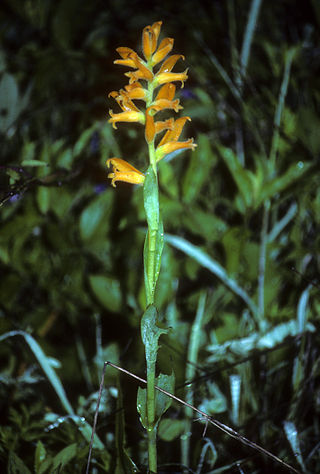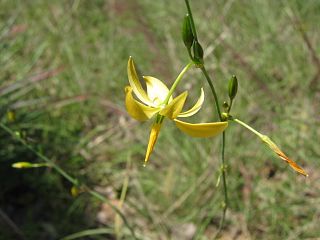
Mesoamerican languages are the languages indigenous to the Mesoamerican cultural area, which covers southern Mexico, all of Guatemala, Belize, El Salvador, and parts of Honduras, Nicaragua and Costa Rica. The area is characterized by extensive linguistic diversity containing several hundred different languages and seven major language families. Mesoamerica is also an area of high linguistic diffusion in that long-term interaction among speakers of different languages through several millennia has resulted in the convergence of certain linguistic traits across disparate language families. The Mesoamerican sprachbund is commonly referred to as the Mesoamerican Linguistic Area.

Arturo García Bustos was a Mexican painter and print maker. He is known as one of “Los Fridos” students who studied under Frida Kahlo at her home in Coyoacán.

Tigridia, is a genus of bulbous or cormous flowering plants belonging to the family Iridaceae. With common names including peacock flowers, tiger-flowers or shell flowers, they have large showy flowers; and one species, Tigridia pavonia, is often cultivated for this. The approximately 60 species in this family grow in the Americas, from Mexico down to Chile.

Govenia is a genus of flowering plants belonging to the orchid family Orchidaceae. The type species, Govenia superba, was transferred from Maxillaria superba and a genus name was given to commemorate J.R. Gowen, secretary of the Horticultural Society of London.

The emergence of metallurgy in pre-Columbian Mesoamerica occurred relatively late in the region's history, with distinctive works of metal apparent in West Mexico by roughly 800 CE, and perhaps as early as 600 CE. Metallurgical techniques likely diffused northward from regions in Central or South America via maritime trade routes; recipients of these metallurgical technologies apparently exploited a wide range of material, including alloys of copper-silver, copper-arsenic, copper-tin and copper-arsenic-tin.

The Pacific screech owl is a species of owl in the family Strigidae. It is found in Costa Rica, El Salvador, Guatemala, Honduras, Mexico, and Nicaragua. The Pacific screech owl has sometimes been treated as a race of western screech owl or eastern screech owl but its vocalizations are distinct from theirs. Two subspecies are recognized, the nominate M. c. cooperi and M. c. lambi. The latter has also sometimes been treated as a separate species. The IUCN has assessed the Pacific screech owl as being of Least Concern. Its population is estimated to exceed 50,000 mature individuals but is believed to be decreasing.

Roldana also known as groundsel is a genus of large herbs or subshrubs from the tribe groundsel tribe within the sunflower family.

The Guerreros de Oaxaca are a professional baseball team in the Mexican League based in Oaxaca City, Oaxaca, Mexico. Their home field is Estadio Eduardo Vasconcelos.
Federal Highway 190 is a Federal Highway of Mexico. Federal Highway 190 is split into two segments: the first segment travels from Tehuantepec, Oaxaca in the east to Puebla City, Puebla in the west. The second segment travels from La Ventosa, Juchitán de Zaragoza Municipality, Oaxaca in the west eastward to Ciudad Cuauhtémoc, Chiapas. Fed. Highway 190's eastern segment ends at a Guatemala-Mexico border crossing at Ciudad Cuauhtémoc. The Pan-American Highway route in southern Mexico continues into Guatemala as Central American Highway 1 (CA-1).
Federal Highway 200, also known as Carretera Pacífico, is a federal highway of Mexico. The Carretera Pacífico is the main leg of the Pacific Coastal Highway within Mexico and travels along the Pacific Coast from Federal Highway 15 in Tepic, Nayarit, in the north to the Guatemala–Mexico border at Talismán, Chiapas, in the south. Upon entering Guatemala, the highway continues as Central American Highway 2 (CA-2).

Coelia macrostachya is a species of orchid. It is native to Chiapas, Guatemala, Honduras, El Salvador, Panama, Guerrero, Oaxaca, Veracruz.

Aulosepalum is a genus of flowering plants from the orchid family, Orchidaceae. It consists of 8 species native to Mexico and Central America.
- Aulosepalum hemichrea(Lindl.) Garay - Oaxaca, Chiapas, El Salvador, Guatemala, Honduras, Nicaragua
- Aulosepalum nelsonii(Greenm.) Garay - Michoacán, Oaxaca
- Aulosepalum oestlundii(Burns-Bal.) Catling - Guerrero
- Aulosepalum pulchrum(Schltr.) Catling - Guatemala and southern Mexico
- Aulosepalum pyramidale(Lindl.) M.A.Dix & M.W.Dix - from central Mexico to Costa Rica
- Aulosepalum ramentaceum(Lindl.) Garay - Tamaulipas, San Luis Potosí
- Aulosepalum riodelayense(Burns-Bal.) Salazar - Oaxaca
- Aulosepalum tenuiflorum(Greenm.) Garay - Morelos, Guerrero

Deiregyne is a genus of flowering plants from the orchid family, Orchidaceae, native to Mexico, Guatemala and Honduras.

Dichromanthus is a genus of flowering plants from the orchid family, Orchidaceae. As currently delimited, it is monophyletic and includes four species:
- Dichromanthus aurantiacus(Lex.) Salazar & Soto Arenas - much of Mexico, south to Honduras
- Dichromanthus cinnabarinus(Lex.) Garay - from Texas to Guatemala
- Dichromanthus michuacanus(Lex.) Salazar & Soto Arenas - from Texas and Arizona south to Honduras
- Dichromanthus yucundaaSalazar & García-Mend. - Oaxaca

Funkiella is a genus of flowering plants from the orchid family, Orchidaceae native to Mexico and Central America.
- Funkiella hyemalis(A.Rich. & Galeotti) Schltr - from central Mexico to Guatemala
- Funkiella laxispica(Catling) Salazar & Soto Arenas - Oaxaca
- Funkiella parasitica(A.Rich. & Galeotti) Salazar & Soto Arenas - from central Mexico to Costa Rica
- Funkiella stolonifera(Ames & Correll) Garay - Chiapas, Guatemala
- Funkiella tenella(L.O.Williams) Szlach. - Chihuahua, Durango
- Funkiella valerioi(Ames & C.Schweinf.) Salazar & Soto Arenas - Costa Rica, Guatemala
- Funkiella versiformisSzlach. - Costa Rica

Rhynchostele is a genus of flowering plants from the orchid family, Orchidaceae, native to Mexico, Central America and Venezuela. The genus name is abbreviated as Rst. in the horticultural trade.

Sarcoglottis is a genus of flowering plants from the orchid family, Orchidaceae. It is widespread across much of Latin America from Mexico to Argentina, with one species extending northward into Trinidad and the Windward Islands.
The Colonial Mexican Period lasted from 1521 to 1821 during the Vice-Regency of New Spain. The cultivation of European music began soon after the arrival of the Spanish, during the Late-Renaissance period of Western Music. Musical practices continually coincided with European tendencies throughout the subsequent Baroque and Classical music periods. It is important to note that while much music was fashioned in European style, uniquely Mexican hybrid works composed of native Mexican language and European musical practice, appeared as early as the sixteenth century, and throughout the colonial period.

Echeandia is a genus of New World plants in the century plant subfamily within the asparagus family.
















